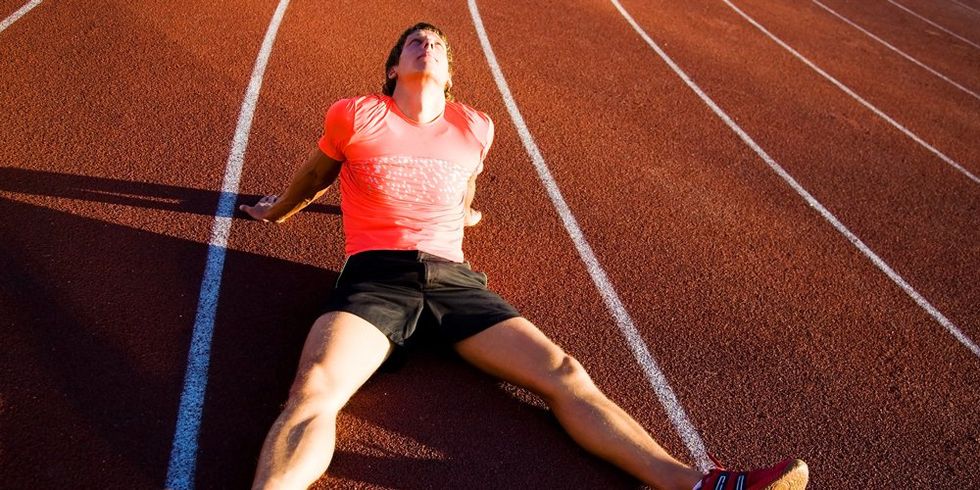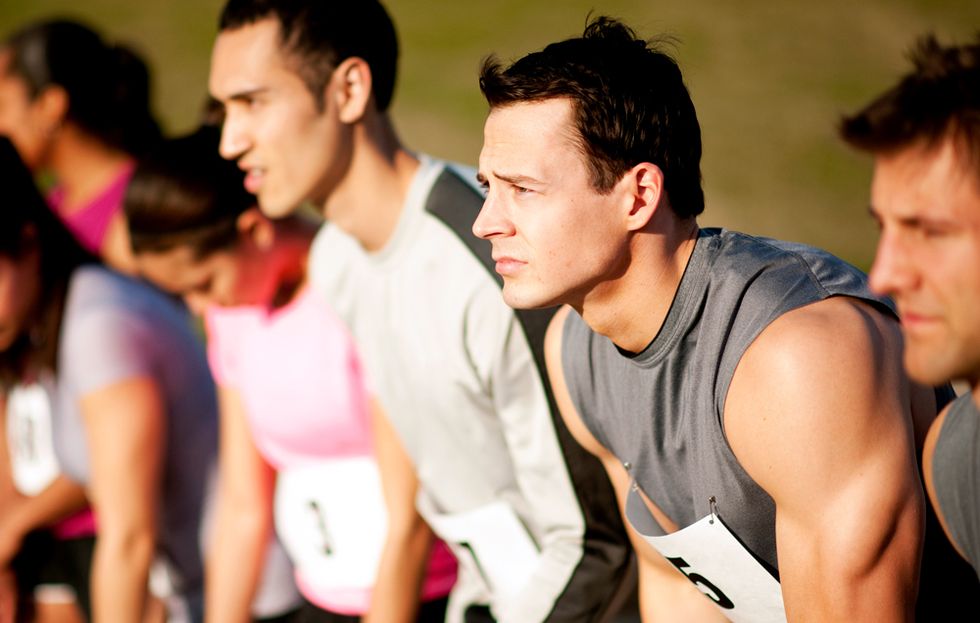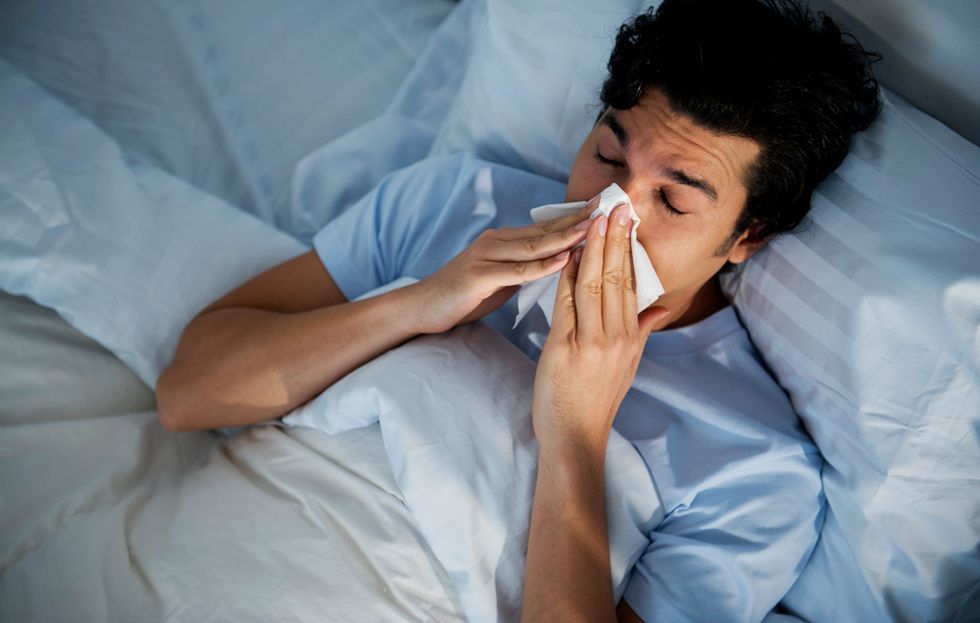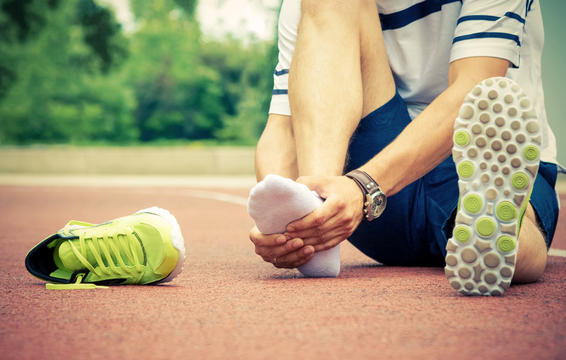And the strategies you need to fight back

BODY BETRAYAL: YOU CAN’T POOP
No one wants to start a race when the urge to poop is brewing. That’s why bringing on your morning poop is extra-important on race days. But what’s a guy to do if his bowels aren’t on board?
The answer: coffee.
“A cup of coffee helps get everything moving inside of you,” says Mark Coogan, an elite running coach with New Balance. “Most of the elite runners will have something with caffeine to help them go to bathroom.”
Coffee sparks contractions in your gut, which triggers the gotta-go urge as the stool travels to your rectum, says Satish Rao, M.D., Ph.D., the director of the digestive health center at Georgia Regents University. So does food, so if you really want to wake up your bowels, have something to eat with your coffee, too.
The caffeine in coffee also has an added perk: It stimulates fatty acids to float around in your blood stream, which you can use as energy early on in the race, says Coogan.
If coffee doesn’t get things moving, try a short jog, a light walk, or a stretch, suggests Terrence Mahon, a high-performance coach for the Boston Athletic Association. Otherwise, says Coogan, if you’re not running for an elite time, hop into a porta-potty when the urge does hit. (Massaging this body part can make you poop, too.)

If you just wake up with the sniffles, you should be just fine to run your race, says Shanna Levine, M.D., a clinical instructor at the Mount Sinai School of Medicine.
A cold dehydrates your body more than usual, so your move is to prioritize hydration and fit in a solid pre-race meal. That can fuel you for the race and replenish lost fluids.
“My favorite race day snacks are a glass of orange juice—which is packed with antioxidants and vitamin C—and whole wheat bread with organic chunky peanut butter and jelly with at least 16 ounces of water,” says Dr. Levine. “This combination provides the peanut butter as a source of protein, the bread as a complex carb, and plenty of hydration.”
If you have a cold, sucking on zinc and echinacea lozenges before the race can also help you feel better, she says. That’s because zinc has been shown to shorten the duration of a cold, and letting the lozenges slowly dissolve in your mouth can soothe sore throat, too.
But if you wake up feeling lousy, you should check your temperature before lacing up. If you have a fever, you should skip that race, says Dr. Levine.
Fevers are your body’s way of mounting an immune response, and as your body fights off the infection, you’re more likely to become dehydrated more easily. Plus, running while you’re ill might stress your body, making your sickness even worse. Consider a fever your body’s way of telling you to take it easy.

You’re running along at a brisk pace when something flies right in your eye—making every blink feel like torture.
If a bug or another kind of debris finds its way into your eye mid-race, it’s likely going to hang out behind your lower eyelid, says Matthew Gardiner, M.D., the director of ophthalmology emergency services at the Massachusetts Eye and Ear. (Sometimes, he says, will small flying objectives make their way to the upper eyelid—and if they do, every time you blink you’ll be in a lot of pain.)
If you don’t want to stop, you can try to blink several times to see if that removes it out—your excess tears may help flush it out—but don’t rub your eye. If that doesn’t work, you’ll need to pause to do some recon.
Your removal strategy: Using your iPhone camera as a mirror or friend, find out where the sucker is. Then, pull your eyelid down, spin a small piece of tissue or paper towel into a point, and wick the fly out.
And PSA for next time: Wear sunglasses, says Mahon. That should prevent bugs or debris from finding their way into your peepers.

You’ve sent the bug packing, but then one more thing pops up to derail your run: the dreaded side stitch.
Side stitches usually hit you for two reasons, says Mahon. The first is the result of too much turning in your lower spine and not enough rotation in your shoulders and thoracic area.
If you feel the stitch in your diaphragm area, the problem might be tied to your breathing. Take a few slow, deep breaths to control your breathing and put pressure on the area that feels cramped to relax the spasm, suggests Coogan.
Another common reason for side stitches is eating or drinking something that isn’t agreeing with you, says Mahon—likely something too acidic or too complex to be absorbed quickly. In that case, try drinking small bits of water to help move the food along, lightly massage the cramping area while you’re running, and take slow, deep breaths.
And for the future, don’t try anything new food or drink wise on race day.

“The inevitable blisters, bloody toes, sore heels, and the like happen so often that they are the badges of honor for many a runner,” says Mahon. But these issues can also halt your run in its tracks.
A lot of shoe comfort comes down to socks. If you feel yours start to crinkle up—and you can spare to lose a few seconds—stop and straighten it out, says Coogan. An out-of-position sock can change your gait and lead to friction, which can mean blisters, he notes.
If it’s a hot day, consider a little Vaseline on your feet, says Mahon. “This will reduce friction and keep your feet from over-heating.”
If you’re a heavy sweater, he suggests adding talcum powder inside your shoes to help absorb excess moisture.
BY CASSIE SHORTSLEEVE APRIL 21, 2017
Additional reporting by Christa Sgobba
Images by Getty Images

 using WordPress and
using WordPress and
No responses yet